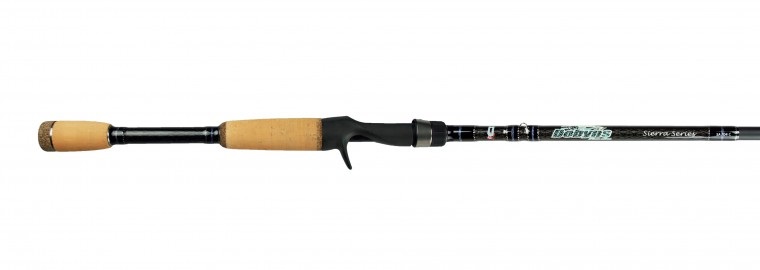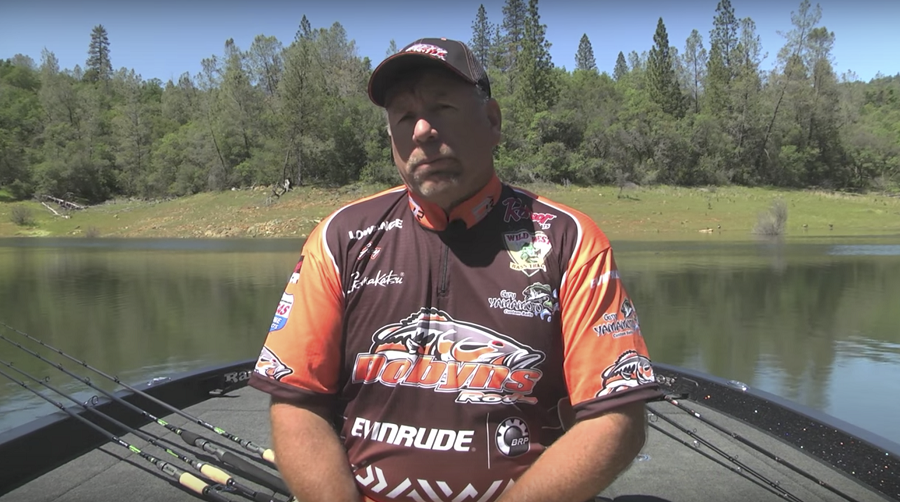
There are many great rods that will work for topwater fishing. Each angler prefers something different from a topwater rod and no single rod will work for the variety of topwater baits bass anglers use. So, how many topwater rods do you really need?
To keep it simple, we asked Bassmaster Elite Series pro Paul Mueller and Gary Dobyns of Dobyns Rods which topwater rods they use for small baits like poppers, average-sized walking baits and extra-large baits.
“There are such a wide variety of models available,” said Mueller. “Some like a graphite rod for topwater and some like a glass rod, but the key in a topwater bait is to have something with a good tip to work the bait and also to have a good parabolic flex so you can land more fish.”
Topwater Rods for Small Walking Baits and Poppers
When it comes to downsized topwaters, there are several options available from spinning rods to lighter baitcast rods.
Mueller prefers a Dobyns 705CB Champion model, but says the rod is available in lower priced options.
“The Fury series in the same model is a very similar blank. I like the 705 because it is a shorter option and good for casting small baits in tight quarters,” he said.
Dobyns Rods makes a rod specifically built for poppers and small jerkbaits.
“The Champion XP 635 is great for poppers, because it is 6’3” and when you are working the bait you are mostly popping it straight down,” said Dobyns. “The shorter length keeps it from hitting the water.”
READ RELATED: 3 Ways for Success with Cold Water Finesse with Paul Mueller
Topwater Rods for Standard Walking Baits
For the majority of topwater walking baits, the same rod will suffice. Both Dobyns and Mueller agree that the 733C is the rod to go with.
“Really, any series of our rods with that model will work,” said Dobyns. “We make the 7’3”, medium-heavy in everything from the Fury to the Champion and they all work great for your standard walking baits,”
When asked what makes it so good for topwater baits, he explained it is all due to the action.
“We purposely slowed the action to make it more versatile,” he said. “It is still a fast action, but it is a little slower. That allows the rod to have a slower action which is what you want to get long casts to load up better to help with longer casts and you also don’t lose as many fish.”
Mueller picked the same rod as Dobyns for standard walking baits and says that he prefers the Sierra series.
“It has a slower action is very versatile,” said Mueller. “It is great for a walking bait like an Ima Skimmer, but you can also use it for bigger poppers, the small Whopper Plopper and prop baits.”
Mueller added that he likes the 7’3” length best for this type of topwater bait.
“A 7’3” rod is great for longer casts and with a little longer rod you can get better tip action and not lose any of the backbone,” he said.
READ RELATED: Deep Crankin and a Dropshot” Two Techniques for an Elite Series Top-5 for Dobyns Rods pro Paul Mueller
Topwater Rod for Jumbo Walking Baits
For fishing big topwater baits like a Super Spook, it takes a hefty rod just to cast a bait that weighs nearly an ounce. The Dobyns Champion 734 was built specifically for this bait according to Dobyns.
“Over ten years ago we built this rod just for the Super Spook,” he said. “It has the perfect action for a big walking bait that you can throw on big braided line and it will also work really well for spinnerbaits, buzzbaits and lipless cranks.”
“That rod is perfect for a big topwater bait,” Muller agreed. “I’ll use that and will go up to the 735, if I am fishing around thick cover and need a little heavier rod.”.
Glass for Topwater Rods
While both Dobyns and Mueller prefer a graphite rod for topwater lures, there are many who prefer a glass rod.
“Our 705 CB is great for walking baits and we sell a ton of them to people who use them for topwaters,” said Dobyns. “What makes our glass rods different is that we make them much lighter than most glass rods. The key is having roughly 40 percent of the rod from the butt section up made from graphite to cut down on weight.”
Mueller also prefers graphite for topwaters but said that those who use braided line for topwater like the glass rod to be more forgiving with hooksets.
“If you fish braided line, you have to compensate for it having no stretch with your gear and a glass rod is a much softer rod and helps to keep the bait from ripping out of the mouth of a fish,” he said.
When it comes to topwater rods, it starts with what types of baits you are fishing and your own personal preferences when it comes to blank material, length, and action. Three rods should cover most topwater needs; a rod that can handle small, medium and large baits.



 Advertising
Advertising